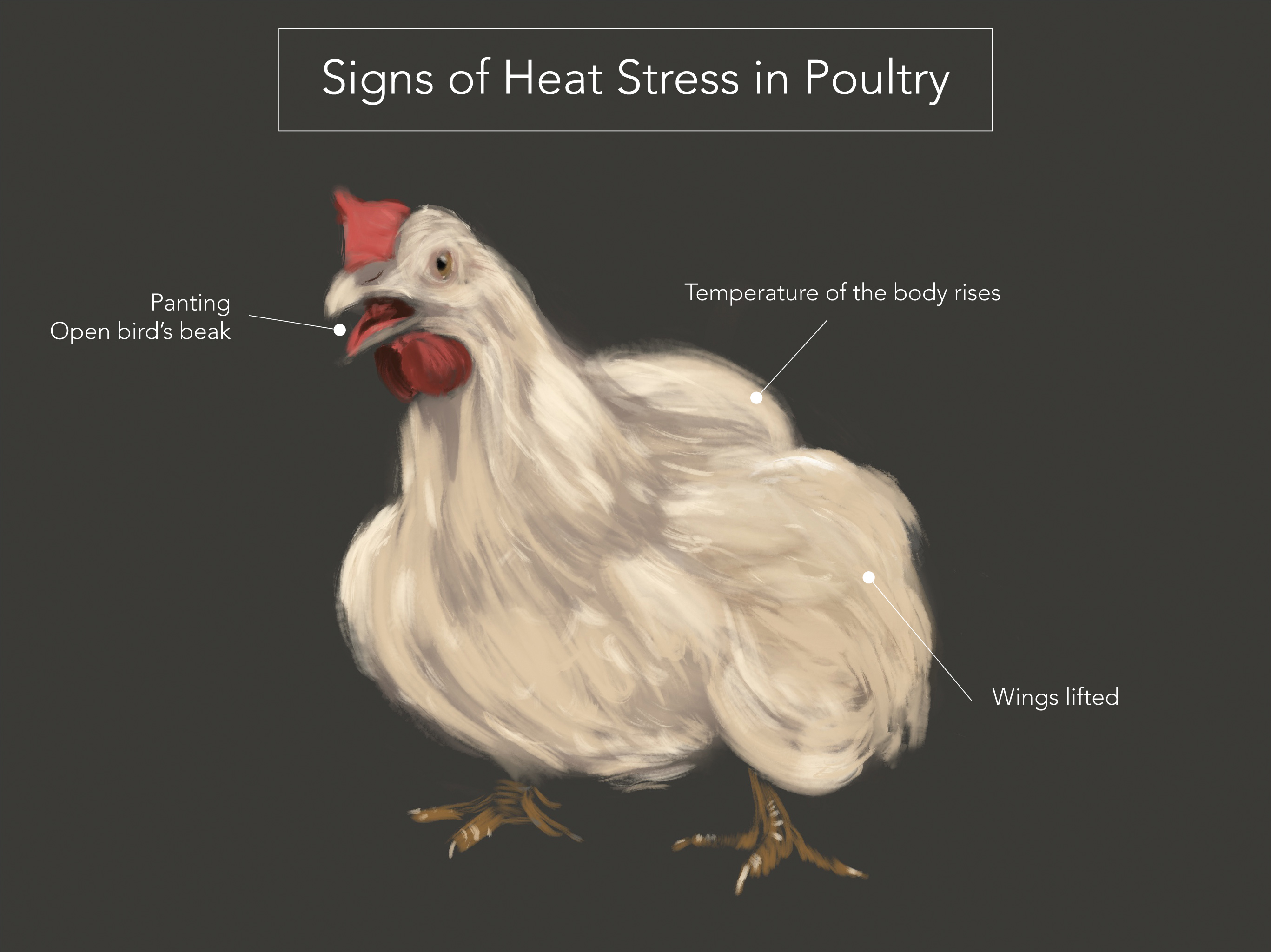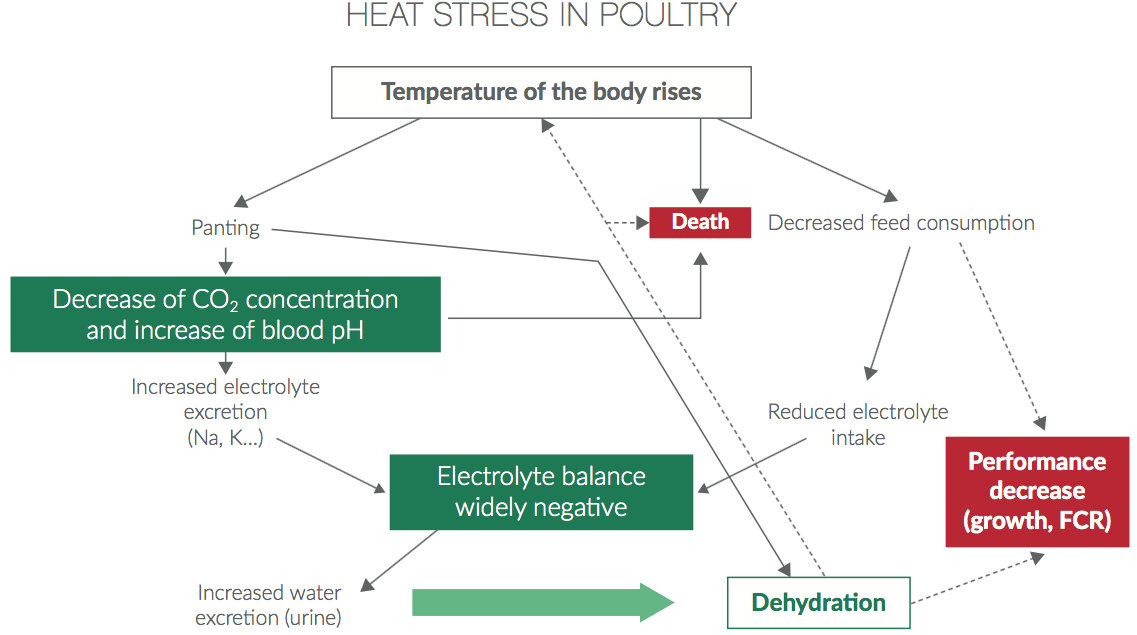The interview - When do we speak about heat stress for poultry ?
From Bertrand Messager, Scientific and Technical Manager for Altilis
Download the pdf : A.T.P. Letter n°1 - Betaine vs Heat Stress in Poultry
The arrival of the first sunny days generally goes together with sudden heat waves characterized by a wide temperature range between day and night. In poultry farming, animals have to face these temperature variations, which expose them to various disorders impacting on health and performance.
This is referred to as « heat stress ». Different kinds of measures are often implemented at housing level like ventilation or misting but such an equipment may not be performant enough to counteract its noxious effects.
We speak about heat stress when housing temperatures are not in line with thermal comfort zone of animals. For poultry, this zone varies according to bird age. Around 30°C for chickens, this value shows a trend to decrease with feathering to hit 20°C for growing animals.
Consequently, great temperature variations as those happening during Spring and beginning of Summer can provoke heat stress with dramatic technical and economic outcomes.
High temperatures, combined with high moisture rate, can be even more problematic.
From one country to another, this issue can take different shapes, requiring adequate measures. For instance, in Asia and in North Africa, the risk of heat stress lasts several months while animals are better able to adapt.
What kind of symptoms in poultry suffering from heat stress can be detectable?
The main difficulty for birds is not to be able to adapt as quickly as temperature rises. Observing animals allows to detect first signs of heat stress. To regulate their body temperature, birds move less even lay prostrated, and stop feeding. A mortality rate increase can be also noticed.
Beyond 30°C, as birds don’t perspire, the only way they have to reduce body temperature is to evaporate heat through increasing breathing rate, which can be multiplied from 5 to 10. This phenomenon is called « panting ». Birds keep their beak open and lift their wings to enhance air ventilation in their feathering and to boost heat loss by convection (see figure below).

Copyright Altilis
Which physiological mechanisms are involved during a heat stress ?
In case of warm temperatures, birds are greatly panting to decrease their body temperature. Through this action, the animal eliminates more CO2, contributing to decrease CO2 blood concentration and increase blood pH.
To limit alcalinization, the animal body will react by eliminating, through urine, bicarbonate ions, with electrolytes in the form of potassium (K) and sodium (Na) ions.
Electrolytes are substances which ionize in solution and conduct electrical current. Blood electrolytes such as sodium, potassium and chlorine contribute to regulate different physiological functions as nerve and muscle function, and also to maintain water and acid-base balances.
Urinary excretion of these electrolytes negatively impacts electrolyte balance. It generates an imbalance of body fluids with, in the end, a loss of water.
As a consequence : animals suffer from dehydration and are not able to maintain a normal body temperature anymore.

Copyright Altilis
What are the technical and economic impacts ?
Heat stress negatively impacts technical and economic performance of poultry farms. Broilers are more susceptible, especially lots of finishing birds, compared to layers for example. The shortfall for breeders is really high.
The effects can also vary according to the temperature degree : at 25°C, there is rather a risk of performance decrease due to reduced feed ingestion than a risk of mortality. From 30°C onwards, the effect on performance is more pronounced. At this temperature, mortality can occur and can hit up to 100% of the flock in extreme conditions, in case of early heat stress and if broilers are in the latest phase of growing.
How to prevent heat stress ? How to face it ?
Currently, there are different ways of preventing and fighting against heat stress to help animals to better resist.
A good building fitting-out remains an important way of action. The best prevention method consists of installing a cooling system, method of air cooling by fogging system, which humidifies and cools air at the building entrance. Nevertheless, in the countries with a strong moisture rate, this method is less efficient. It is also possible to install devices increasing air speed in the building. Such equipment can be really efficient but due to their energy and economic cost, it is not so easy to put them in smalls poultry farms.
So, it seems essential to find other complementary measures, especially through animal feeding and dehydration.
During hot season, it is recommended to stop feeding the animals during the day and then feed them at night. It is also suggested to increase the energy proportion brought by the feed in the form of fat.
In case of heat stress, the main aim is to act in real time by stimulating water consumption and by using feed for preventing dehydration and electrolyte leakage.
This leakage can be offset by providing, through drinking water or feed, electrolytes or even better osmolyte (betaine, inositol…) without any negative impact on water consumption.
Our team has designed and developed a range of nutritional solution based on betaine which promotes a better osmoregulation in case of heat stress. We suggest to keep on following us to discover the mechanism of action of betaine and also its benefits in poultry.
